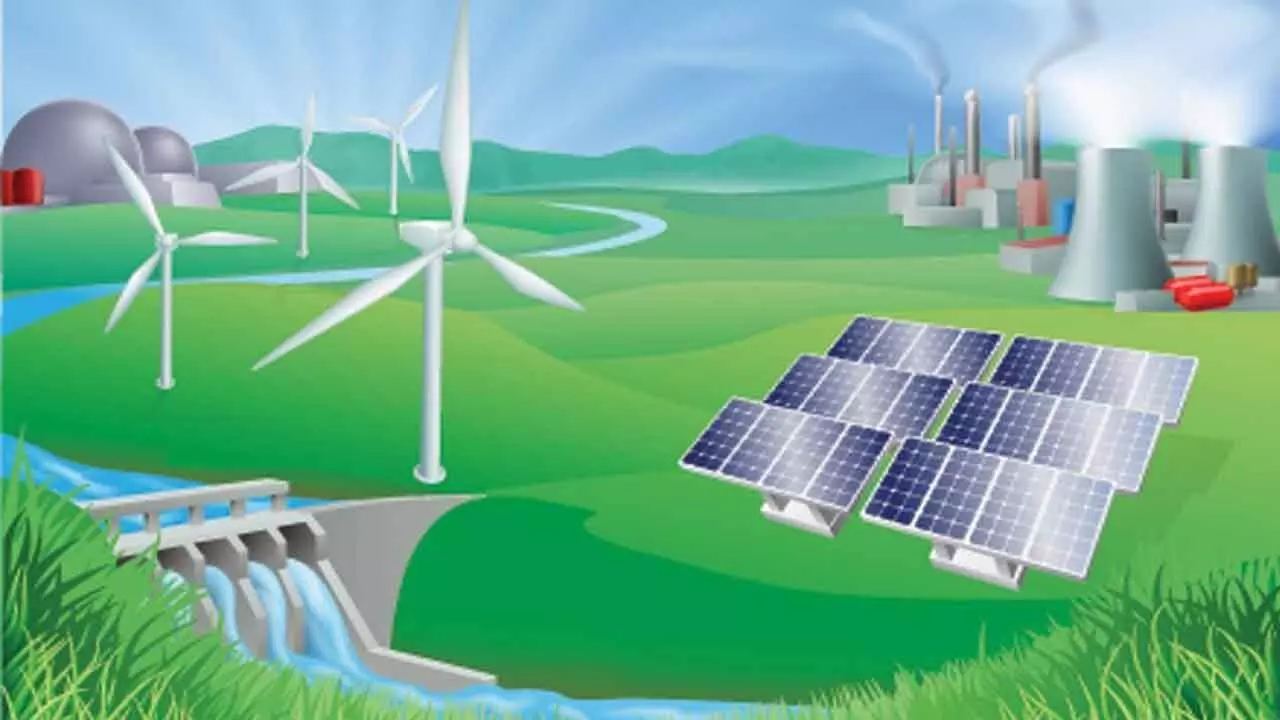India Nears 50% Non-Fossil Power With Ambitious Green Energy Push
A transformative energy shift is underway as India accelerates toward a low-carbon, resilient energy economy powered by renewables, innovation, and inclusive access
India Nears 50% Non-Fossil Power With Ambitious Green Energy Push

India is steadily advancing towards a more diversified and sustainable energy mix, with a growing focus on renewable sources, bioenergy, nuclear power, and storage technologies. As of February 2025, non-fossil fuel sources account for 47.4 per cent of the country’s total installed electricity generation capacity. This includes solar energy (21.8 per cent), wind power (10.3 per cent), hydropower (10.0 per cent), and nuclear energy (1.7 per cent).
India is rapidly scaling up its solar capabilities through both grid-connected and off-grid initiatives. Under the Solar Parks Scheme and Ultra-Mega Solar Power Projects, the goal is to establish 40,000 MW of capacity. So far, 55 solar parks across 13 states have been sanctioned, with a combined potential of 39.9 GW—12.2 GW of which has already been commissioned by December 2024. Tamil Nadu, Gujarat, Maharashtra, and Karnataka remain frontrunners in wind energy development.
The PM-KUSUM scheme focuses on decentralised solar deployment, targeting the addition of 34.8 GW of capacity by March 2026. It includes:10,000 MW of small solar plants on unused and agricultural lands (Component A), 14 lakh stand-alone solar pumps for off-grid use (Component B), and Solarisation of 35 lakh grid-connected agricultural pumps (Component C).
As of March 2025, over 7.7 lakh stand-alone pumps have been installed, and 3.3 lakh grid-connected pumps have been solarised.
The PM Surya Ghar Muft Bijli Yojana aims to bring solar power to 1 crore households by March 2027. Additionally, new schemes under PM JANMAN and DA-JGUA are electrifying 1 lakh tribal and PVTG homes across 63,843 villages, alongside off-grid solar lighting for 1,500 community centres and solarisation of 2,000 public institutions.
To promote offshore wind energy, the government launched a Viability Gap Funding (VGF) scheme with a budget of Rs7,453 crore—Rs6,853 crore for 1 GW offshore wind projects in Gujarat and Tamil Nadu, and Rs600 crore for port infrastructure upgrades. The Green Energy Corridor (GEC) initiative is also enhancing transmission infrastructure, with GEC-I having installed 9,136 circuit km of lines and 21,413 MVA of substations. GEC-II is underway in seven additional states.
While renewable energy scales up, coal-based power remains essential for base-load demand. The government is enhancing thermal power efficiency through supercritical, ultra-supercritical, and advanced ultra-supercritical technologies to reduce emissions and fuel consumption, supporting a smoother transition to a low-carbon energy grid.
The National Bioenergy Programme supports waste-to-energy projects, biomass cogeneration, and biogas. As of December 2024, biomass installations reached ~9.8 GW, and off-grid biogas about 0.92 GW equivalent. Under the National Green Hydrogen Mission, India aims to produce 5 million metric tonnes of green hydrogen annually by 2030. Already, 412,000 tonnes of production capacity and 3,000 MW of electrolyser manufacturing have been awarded.
The Nuclear Energy Mission, launched in the 2025–26 Union Budget with a Rs20,000 crore allocation, targets the development of indigenous Small Modular Reactors (SMRs) and aims to scale nuclear capacity to 100 GW by 2047.
India has nearly achieved universal access to clean cooking fuel through the Pradhan Mantri Ujjwala Yojana (PMUY), significantly improving household energy access.
The Perform Achieve and Trade (PAT) scheme, launched in 2012, continues to enhance industrial energy efficiency by setting reduction targets for high-consumption industries. As of March 2023, the scheme saved approximately 26 million tonnes of oil equivalent and cut over 70 million tonnes of CO₂ emissions. A 2022 amendment to the Energy Conservation Act introduced the Carbon Credit Trading Scheme (CCTS), covering nine energy-intensive sectors such as aluminium, cement, and steel.
Energy-efficient infrastructure is also gaining traction: UJALA: Promoted widespread use of LED lighting. ECSBC & Eco Niwas Samhita: Set standards for commercial and residential buildings. Star Labelling by BEE: Encourages adoption of energy-efficient appliances. GRIHA: Now mandatory for all new government buildings, promoting sustainable construction.
(An extract from 'Draft Framework of India's Climate Finance Taxonomy' of the Ministry of Finance)

